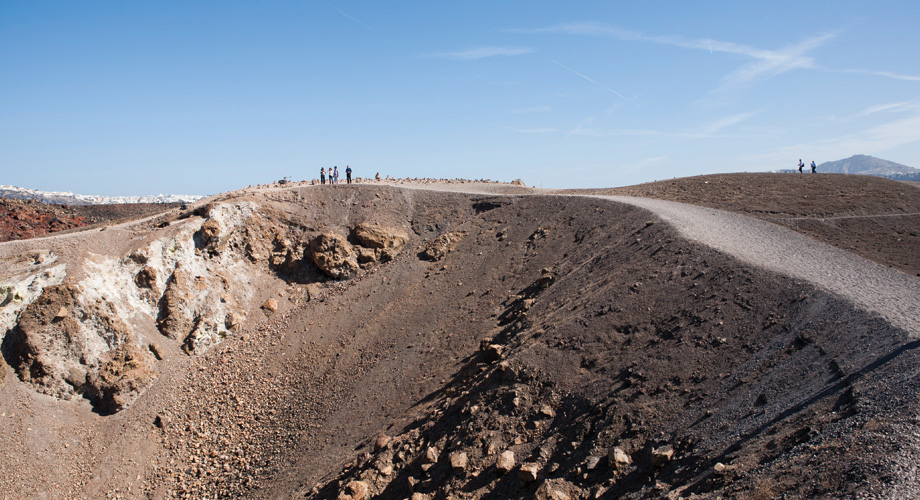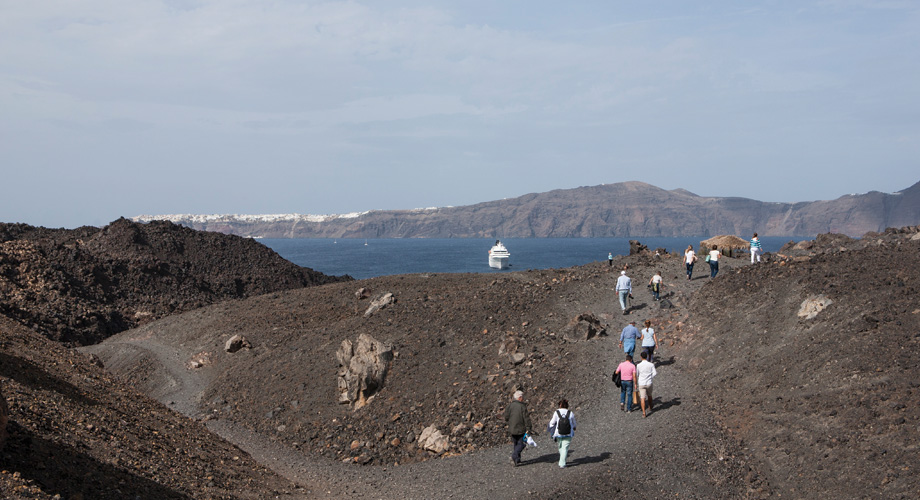The Volcano of Santorini
Discover the ancient secrets and fascinating geology of the world-famous volcano of Santorini, which shaped the island and defined its fate with the massive Minoan Eruption, known to be among the largest volcanic eruptions in history.
Listen To The Sigh Of The Volcano
A Wild Natural Wonder
The Creation of Santorini
Santorini is one of the most violent volcanoes in the world, with its activity starting two million years ago, and it took thousands of eruptions to form Santorini as we know it today.
In just the last 400,000 years, there have been over 100 eruptions, each adding a layer of earth and stone, expanding the island.

The first eruption occurred southwest of Santorini, creating a large volcanic structure in the area where the islets of Christiana are located today.
The position of the volcanoes in Santorini is controlled by a deep tectonic line that starts from Christiana and extends to Amorgos Island.
The volcano became active again a million years later, this time further north between Thirassia and northern Thira, where a shield-shaped volcano called Peristeriou Volcano was formed. At the same time, other small volcanoes became active in Akrotiri, Balos, and Red Beach.
Every 20,000 years, major eruptions occur, ejecting billions of tons of volcanic ash into the air.
Only a small portion of this material settles on Santorini, forming successive layers of ash.
The cycle of the volcano’s destruction and rebuilding has repeated 12 times over the past 400,000 years, creating the thick layers of ash that testify to the large eruptions and the solid volcanic rocks that reveal the formation of volcanic centers, only to be destroyed by subsequent eruptions.
A window to the past
Historical Times
The history
The Minoan Eruption
The most significant moment in the history of Santorini’s volcano is, of course, the Minoan eruption, which, according to the latest findings, is dated to around 1630 BC. A series of earthquakes and smaller eruptions warned and prompted the inhabitants of the once-thriving society of Akrotiri to abandon the island.
Details of the Eruption
The eruption is estimated to have lasted only a few days, ejecting 90 billion tons of molten rock into the air – about 39 cubic kilometers of magma. The collapse of the crater into the massive underground cavity created by the ejection of the molten rock formed the current caldera of Santorini. The volcanic ash traveled eastward as far as Asia Minor, depositing a 30-centimeter layer of ash on Rhodes, Kos, and the lakes of Asia Minor.
Volcanic Winter
The fine ash reached the stratosphere, veiling the entire planet and causing a “volcanic winter” with a temperature drop of 1-2 degrees Celsius. The tsunami that was triggered swept across the coasts of the Aegean and the Eastern Mediterranean.
The Tsunami
This tsunami is said to have destroyed the Minoan civilization in Crete, but modern findings now prove that this did not happen, as the civilization had already begun to decline by 1450 BC. There is no further evidence to imply that life was interrupted due to the eruption of Santorini’s volcano.
Palia & Nea Kameni Islands
The two islets located at the center of the Santorini archipelago, Palia Kameni and Nea Kameni, are what we call “the volcano” today. The islands were formed by successive eruptions and are of great geological interest.
Underwater Treasure
Koloumpos Volcano
Another extremely interesting volcanic case in Santorini is the underwater volcano of Kolumbo, located 8 kilometers northeast of the island and near the beach of the same name. The only recorded eruption took place in September 1650, during which 4 billion tons of molten rock were ejected into the atmosphere, and the floating pumice made the surrounding area appear like land.
The eruption created an underwater caldera 500 meters deep and 3 kilometers in diameter. This eruption has been documented in various written reports from the time.
The major issue caused by the eruption was the release of massive amounts of hydrogen sulfide, which resulted in the deaths of 50 residents and more than a thousand animals. This period became known in Santorini as “the time of evil,” and to ward it off, the church of Panagia tou Kalou (Virgin Mary of Good) was built in the area of Kolumbo.
This eruption is the largest that occurred in the Eastern Mediterranean in the past millennium, and today, the Kolumbo volcano remains in a state of dormancy.
Today, the volcano is inactive, and you can easily visit it through organized tours or by arranging a visit on your own.
Here are some points of interest you will encounter as soon as you arrive. The first lavas you will see belong to Nea Kameni, and you will disembark at the cove of Erinia (named after the wild fig tree, which can also be found on the islet). From here, the unique trail begins for you to explore the volcano.
Around you are lavas, primarily from the eruptions of 1570, 1940, and 1950, as well as volcanic bombs that measure up to 2 meters long. From here, you will reach the summit of the dome of Mikri Kameni and see the central crater, the lava flows of Daphne, and the domes of Fouque, Rek, and Smith. The path leads to the highest peak of Nea Kameni (127 meters), where you can admire the two large craters formed in 1940.
The visit continues by boat, where you can swim in the famous hot springs of Agios Nikolaos on Palia Kameni and enjoy the otherworldly and utterly enchanting scenery with the volcanic slopes and lavas in this unique geological creation of nature.
